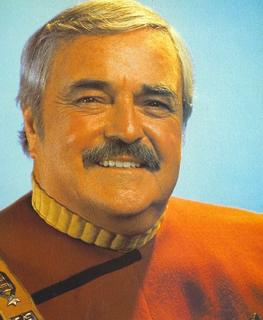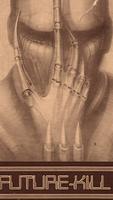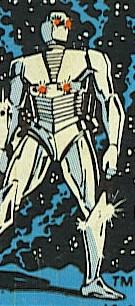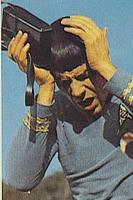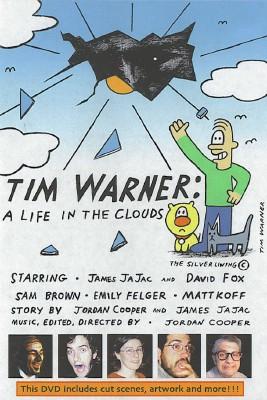 As I indicated a few posts back, I want this blog to profile and interview filmmakers working outside the Hollywood mainstream. Ones who are doing good work and doing it their own way. These artists are my heroes because they aren't buying into what others tell them to do, and instead are creating entertaining works based on their own personal aesthetic.
As I indicated a few posts back, I want this blog to profile and interview filmmakers working outside the Hollywood mainstream. Ones who are doing good work and doing it their own way. These artists are my heroes because they aren't buying into what others tell them to do, and instead are creating entertaining works based on their own personal aesthetic.
Anyway, this week, my filmmaker interview is with the delightful (and very young...) Jordan Cooper, the director of a documentary-style comedy (or mockumentary...) entitled Tim Warner: A Life in the Clouds
.
Some background: Late last year, Applause Theatre and Cinema Books published my fifteenth book, a study of the fantastic Christopher Guest (Waiting for Guffman, A Mighty Wind, etc.) entitled Best of Show: The Films of Christopher Guest and Company. Soon after, Jordan contacted me through my home page and asked me to take a gander at his student film, which is a mockumentary of a vastly different stripe.
Well, this is has been a busy year, and to my chagrin, it took me months to look at his work. Like 8 months. Well, I finally did screen The Silver Lining with my wife Kathryn just a few weeks ago, and I was astonished by the professionalism of Jordan's film. Much more to the point, I laughed my ass off. I've grown so tired of mass-produced, hollow Hollywood comedies like Dodgeball, Meet the Fockers, Anchorman or Envy because they tend to be stupid, empty films that rely on old formulas. You know what I'm talking about: a bunch of loveable losers get together to accomplish some task, fight powerful bad guys, have a falling out, and then emerge triumphant. It's been done a million times. I can say without reservation that I laughed more times in Jordan Cooper's film, Tim Warner: A Life in the Clouds (about a misanthropic comic strip artist...) than I have during any of those aforementioned films. It's goofy, wickedly satirical, and ultimately touching in some weird way. It's a low-budget film, so naturally it is rough in one or two very minor ways (make-up and occasionally pacing), but the editing is absolutely superior, and most of all, the ideas behind it are hilarious. So there you have it.
I wanted to know more about the film and about Jordan, so I asked if he was game for an interview, even though I'd been dilatory about getting back to him. He consented, and I'm happy to present the conversation here. James Jajac, co-writer and actor in the film also joins us briefly.
MUIR: Tell me a bit about yourself and your education. How did your interest in film develop, and which filmmakers are inspirations to you?
COOPER: I live in Kew Gardens, Queens! My main interest is actually music and songwriting. I have written almost 200 songs. When I was 13, I went to an arts camp and took video there, where I made some music videos and little fake commercials. I noticed that when holding a camera, I got very bossy, and tons of ideas would pop into my head, and realized I enjoy taking charge of a film shoot. So I went to School of Visual Arts here in NYC as a directing major. I hated a lot of student films, which only served to motivate me more.
I've never been a huge film fanatic, and I'll often fall asleep during some great movies. But as a creative medium, it can't be beat. It incorporates everything...you can have something visually creative, or the timing of a shot could be creative, or the way something is cut. Something in the sound could be funny, or meaningful. Film just involves every aspect of the arts, and because of that, I often appreciate movies that use a lot of original artwork and music. Specifically I get shivers when music and film react perfectly to each other.
The films that started blowing me away were Kubrick films. A Clockwork Orange invaded my brain in high school. Kubrick's films (and I still haven't seen them all...) really showed me that a film - and the performances within a film - can be hypnotically good. You just can't turn away. I got a lot of enjoyment out of Coen Brothers movies too. I was very inspired by the way even their seemingly silly comedies would have a thoughtful otherworldliness to them. Something more to sink your teeth into.
Brazil by Terry Gilliam blew my mind as well, though it took about 5 times for me to completely fathom it. My absolute favorite movie is True Stories, directed by David Byrne. It's like the perfect movie to me. It's hilarious, and touching, and WEIRD, and it's about everything. It's got a loose vibe where you can imagine David Byrne just saying "I want to see this weird thing in my movie, so I'm just going to put it in," and he did.
MUIR: Could you give my readers a description of your film, Tim Warner: Life in The Clouds?
COOPER: What I always say is: It's about a horrible cartoonist who is a miserable bastard, and everybody loves him. Tim Warner is the creator of "The Silver Lining," a completely average, mediocre (at best!) newspaper strip. It's incredibly popular (go figure...). The first part of the movie is a sort of a TV fluff piece: we meet his fans, family, see the strips' highs and lows. But then as things start going wrong, the style of the film becomes more voyeuristic. A rival comic strip artist knocks "The Silver Lining" into the Obituaries section, and to settle this dispute, the two cartoonists engage in a ridiculous and bloody rooftop fight scene. Who could ask for more?
MUIR: Describe the conception and shooting of the piece...
COOPER: My friend and I took a lot of notice of how bad daily comic strips in the newspaper were. Not just bad, but disturbing and insulting. "Garfield" in particular has seemed almost suicidally depressed lately. One night, we videotaped a very quick improv of an interview with "Tim Warner." The idea was that these comic strips are SO bad, so mundane and without personality at all, so WHO'S doing them? What is that person like? We thought it was hilarious to personify the very idea of bland passionless art. It's not JUST about comic strips, but really boring soulless art in general.
By the way, some REALLY BAD comic strips : "Girls and Sports", "Zits" , "Mallard Fillmore" , "State of the Union."
I showed this quick rough version to my film class (it was a slow lesson day) and it got a surprisingly positive response. A year later I needed a thesis film, and that seemed like something we could get a lot of guaranteed laughs out of.
First we answered a bunch of random questions about "Tim Warner." i.e. his favorite food (pears), his biggest fear, etc. We thought of what other characters could pop in and out. We sat on it for a long time and let ideas come to us, which is something I have to do because I'm not good at thinking of ideas on command.
We got together one day and in an intensive writing session hammered out the entire detailed outline of the movie, with almost all the plot points, characters, locations, etc. That was a relief. My co-writer James Jajac [who also plays Tim Warner] and I worked off each other excellently. I have a tendency to think of half ideas, and James is great at finishing the other half. Meanwhile James tends to think of an idea that is funny but maybe without context, and I'd be good at having it make sense. James IS Tim Warner, so a lot of the ideas involving quirks of the strip itself would come from him drawing and drawing. For example, he came up with art concepts such as: "Squiggles never smiles or changes his facial expression." Also, our friend Dave who plays "Lance Gold" thought of the idea for a rival cartoonist in the first place, though it was only a small detail until we surprised Dave by telling him it was now a HUGE plot point (what the heck, the ONLY plot point...).
MUIR: What was your film's budget?
COOPER: There wasn't a specific budget, but most of it was spent on props and post production. I needed new equipment to make the music, and I also needed a hard drive to store all the footage. Ouch.
MUIR: You shot digital?
COOPER: Yeah, we shot with the digital camera the school gave me. However I changed the settings and frame rates depending on where we are in the movie. The first half is meant to look more like TV video, the 2nd half is meant to look a bit smoother, more natural, like a handheld "realistic" documentary. I wish I could have shot on film, but I like to think I used the medium of video to it's strengths. This type of project isn't really supposed to look like film anyway. It was a one man crew. Just me on the camera, that's it.
MUIR: How long did the project take to shoot?
COOPER: It took 2 full weeks to shoot. 2 weeks is actually a LOT of time for a student film, so we allowed ourselves freedom to go at a somewhat leisurely pace. Some days I'd shoot multiple interviews, other days we'd just grab a quick shot and relax for the night. Throughout the long shoot, I was already editing the movie in my brain.
MUIR: Mockumentaries are a breed all unto themselves. People think they are easy to shoot, but in fact the opposite is true. Did you have a detailed script, or, like Christopher Guest's documentary-based commentaries, did you merely go by a detailed outline?
COOPER: I had never done anything like this before, and I intentionally stayed away from Spinal Tap, and Christopher Guest's films. I still haven't seen Spinal Tap actually. I love the subtlety in Guest's films, but I wanted to make a mockumentary that WASN'T subtle. I wanted it to be really manic and silly, and sort of slamming in your face how ridiculous everything is. That sounds like it wouldn't be funny, I know, but I really felt it could be different by being as direct and unforgiving as possible, and not so much "realistic." I think sometimes Guest's films are TOO subtle anyway. It's funny because when I was reading your book about Guest, I noticed your formula you have for making a successful mockumentary sort of contradicted what I had done, which is what made me curious for you to see it!
James and I came up with a ton of different ideas. It was a personal goal of mine to make a movie where we would spend a whole day on a shot, or making a prop, spend a lot of money even, only to have it be a small detail in the film. I love how impressive that is. So we came up with ideas and story elements that would intentionally give us a lot of hard work to do, because we knew how well it would pay off.
MUIR: Well, I have to say, I think that your film is very original. You don't stick to the traditional structure of a three-act story, or develop the plot in an expected way. For me, this is a great strength of your film. It's unconventional and fresh.
COOPER: Storytelling was never my strongpoint. Most of my earlier films lack a strong story, so it was really hard to think of plot points. That may be why the plot awkwardly starts towards the END of the film. In the outline we specified every detail of history about Tim Warner and his life, every topic of conversation the interviews would cover. However the outline contains almost no actual jokes. It just states the topics people will talk about: Tim's childhood, Cousin Eskimo, etc. On the set is when most of the content was actually created. The 2nd half of the movie was planned out more specifically, and the fight scene was storyboarded.
MUIR: How did you enjoy directing?
COOPER: Directing the movie was incredibly fun, mostly because everyone on camera is a friend of mine. I didn't use any professional "actors." My friends can just read my mind so much easier, and know exactly what I want. We didn't rehearse much at all, except preplanned things like the fight scene and certain details we knew had to come up.
Sam, who plays Brian the Squiggles-Maniac, preferred to do a few takes with the camera off first. Matt, who plays Professor Nougat, just rambled on and on and on. After he'd finish, I would tell him what was funny, and have him do another, tighter take with more emphasis on that particular line. He also mostly stayed in character when the camera was off.
James, who plays Tim Warner, wrote out beforehand a lot of jokes and lines he wanted to say, and together we would figure out the most efficient way to get them across. The part when Tim Warner is very LOUDLY scratching the microphone on his chest was unplanned, James just did that and I started dying laughing. We then did some more takes to get the sound just right. It's one of my favorite parts cause the joke has nothing to do with anything in the movie, except maybe how oblivious Tim Warner is to how he's really being portrayed in this "documentary."
The book signing scene was beautiful because I barely directed. Everyone was so in character that day, and when they'd interact with each other it really took on a life of it's own. That scene, and the awkwardness within it (Brian handing Tim a GIANT "SQUIGGLES #1" sign), is why you make a mockumentary.
A lot of people off the street are in the movie as well. Half of the book signing customers are actual people who just wandered into the store, including the very angry man who forces Tim Warner to sign his son's book. He just walked in off the street and made all that up in one take! What you're seeing is not only unrehearsed, but we never even MET that man before, and we only very quickly explained what the scene was about to him. Amazing. The movie is filled with unpredictable moments like that, things we never would have thought to put in the outline.
MUIR: One thing that floored me about your film is the level of pre-production and preparation that must have been involved. For instance, throughout the film, you cut to the comic strip frames as your B-roll, both Tim Warner's The Silver Lining (and later Silver Hell), and then the evil strip - Sitting Ducks. You also feature a gaggle of Silver Lining merchandise. This was just amazing to me. Describe, if you can, the process of producing the strips and this ancillary merchandising stuff. Why was it important to the film?
COOPER: So much work. Luckily I didn't have to do much of it, ha! James is an amazing illustrator and had to dumb himself down about 99% in order to draw "The Silver Lining." James and Emily, my then-girlfriend, took charge of all the propmaking. She made the puppets that her character Melissa plays with. I made a few magnets though, and sketched out some ideas. I made a lot of the dolls, which would take hours and hours to hand sew the T-shirts onto them.
It was extremely important to really convey the hugeness of "Silver Lining." The bigger the strip is, with all it's merchandise and history, the funnier the entire idea of the movie is. We wanted to make a "freeze frame" movie, where we'll work on a prop for a week just to have it in the movie for 2 seconds. I specifically wanted people to say "wow, you did a lot of work" when watching it, and that's what most people do say!
Mainly the goal was to be as non-stop funny as possible. We can't really make a product without putting a joke in it, sometimes just to amuse each other, so that's why there's so many of them piled on each other. For example the Silver Lining bedsheets, which are oddly sexual and gross. Or the Silver Lining light switch, which has the audacity to quote God and says "Let there be light!" Or the "So you got your tonsils out!" greeting card that Berkeley Breathed is holding. Or the "Silver Lining" mirror, which is hilariously without function being that the Silver Lining characters are obnoxiously blocking most of the glass (that still makes me laugh). Or the retarded names of the Silver Lining treasury books. For us, it's all about the details. They simply make people want to watch the movie multiple times. Honestly, our goal was to amaze people (including ourselves!)
To shoot the actual b-roll of them was arduous and not one of the highlights of the shoot. To make all these props took about 2 months. Many of them were still being made halfway into the shoot. It was at literally the last minute when I got a lot of the finished strips! James was really responsible for most of it. We'd talk about what we wanted, then the next day he'd show up at my house with something hilarious. Often he wouldn't even tell me what he was going to do. For example the Squiggles hat that Brian wears was a surprise to me. James just did it without me knowing about it. Also, most of the strips and fake advertisements (i.e., "always wear a helmet!") were created independent of me. I came up with a few of them, to take some of the load off of James, but he really just created mountains of this stuff.
the shoot. To make all these props took about 2 months. Many of them were still being made halfway into the shoot. It was at literally the last minute when I got a lot of the finished strips! James was really responsible for most of it. We'd talk about what we wanted, then the next day he'd show up at my house with something hilarious. Often he wouldn't even tell me what he was going to do. For example the Squiggles hat that Brian wears was a surprise to me. James just did it without me knowing about it. Also, most of the strips and fake advertisements (i.e., "always wear a helmet!") were created independent of me. I came up with a few of them, to take some of the load off of James, but he really just created mountains of this stuff.
Also, the "Silver Hell" strips were maybe the best details of the entire movie. When James first showed them to me I knew we had ourselves something really special and hilarious. That always gets HUGE reactions at screenings. I mean if you really study those strips, wow, they are completely insane, and there's lots of little hidden things in them too (freeze frame!)
JAMES JAJAC: With the strips basically what I was trying to do was bring an air of authenticity to it. I based a lot of "The Silver Lining" on strips that operate on a format (repeats the same jokes and gags over and over again). Garfield used to be very energetic and funny but now it seems like the characters are straight out of a dictionary and they don't do anything new or interesting or challenging or funny with them. And so The Silver Lining is an exaggerated version of all the strips we didn't like ,and I wanted the characters at the very least to be believable creations, with a world that you could buy into. I think The Silver Lining is more a product than it is a comic strip with a point of view. It is basically the opposite of anything that we would like in a comic strip, no jokes, no energy, no character at all, though I happen to enjoy the design of them. If I was a kid I know I would have read it.
My personal favorite product is the Silver Lining bed sheets, with a nearly nude life sized TED sprawled out beside you (its kind of seedy if you think of it as a kids strip). It goes by so fast I don't even think it registers with people, which might actually be good; I still laugh every time I see his oversized nipples. We wanted it to seem as if there was an endless variety of products, a "flood of merchandising". Credibility "mon frere" (to quote my brother, who is a french poodle). We wanted everyone to believe us!"
MUIR: One of the interesting things about mockumentaries is that filmmaker's shoot them like a "real" documentary (with hours and hours of footage), and then have to trim away in the editing process - a process that can take months. What equipment did you use to edit the film, and how long did it take to pare down to its current length? How did you go about choosing which material to retain and which had to go?
COOPER: I edited using Final Cut pro, at my school and using my then girlfriend's computer, which was very stressful. I had 15 hours of footage. That may not sound like a lot, but here's an example of how overwhelming that was: My previous film had only 1 hour of footage, which got cut into a 15 minute film. To cut this film was very difficult and took 2 months. Now for "Tim Warner" I had 15 hours of footage and still, only about 2 months to edit. The fight scene alone was like editing a short film onto itself.
Editing was heartbreakingly difficult. I literally cried during that process. The first version of the movie was an hour and 15 minutes long, and while a lot of it was funny, it just did not work as a feature. I can be very stubborn though and did not easily cut the movie up. Some of my favorite things I've ever shot had to be chopped off, including a ton of hilarious Professor Nougat footage, and even whole other plot points and characters. I was a character in the movie but I cut myself out (which I didn't mind). I played a newspaper cartoonist who gets sued by Tim Warner for having a cat say "meow" in his own strip.
I was absolutely baffled as to the structure for a while, and thought it was too weird to have the plot start towards the end. I think with most filmmakers, they reach a point in the editing when suddenly nothing makes sense to you anymore. You just don't understand the film and have no clue how to organize and convey it. That definitely happened with Tim Warner.
You may notice the movie has a LOT to set up. The audience HAS to understand "The Silver Lining," all the names of the characters, they really have to feel like they know the strip, because every joke in the movie plays off that history. I couldn't figure out how to shorten the intro because we have so much information to introduce, or else none of the jokes LATER will make sense. We need people to feel they've been reading about Squiggles, Ted, and Doggy their entire life, so that when we tear it all apart it feels significant.
My favorite scene to edit was the fight scene, because I like editing in real time, where you have to follow actions with multiple camera angles, and make the scene really exciting. Editing the talking heads interview footage was often perplexing, but sometimes by coincidence two different things that two different characters would say would just happen to play off each other perfectly. For example Melissa says about Doggy - "He's just a fat little dog!", to which the Professor replies, "JUST A DOG? NOOO! A CLITORIS!" I loved how they, without realizing it, talked to each other.
As hard as it was, I still wish I could cut more out of it though. After seeing the film 100 times, I feel like I could easily chop off another 5 minutes.
MUIR: I'm sure you always get asked this, but is Tim Warner based on any cartoonist/comic-strip artist in particular? What do you think the film says about fans and scholars who study these things? Were you out to make a particular point, or just create a funny movie?
COOPER: One day when reading the "Funnies," I noticed that "Mallard Fillmore" took a jab at "Doonesbury." I was shocked, but mostly thought it was one of the most pathetic and juvenile things I have ever seen. The 2nd half of the movie was based on that. "Sitting Ducks" is "Mallard Fillmore." "Silver Lining" is very much based on "Garfield," "Ziggy," "That's Life!". The way comic strips have declined in quality over the years, especially compared to amazing old ones like "Pogo" by Walt Kelley, Or "Popeye" by E.C. Segar.
We weren't really out to make fun of fans or scholars. There are comics out there worth studying. But the idea of everybody embracing this comic that is so bland and offers NOTHING new or interesting, I suppose that was a commentary on certain pop culture trends. We hope that when that first "Silver Lining" strip shows up, the audience really gets the joke - that it is BAD and NOT worthy of a documentary. We hope they can think of something they hate that's popular as well. Everyone has their own "Silver Lining," where you just can't believe how popular it is, cause all you're seeing is crap.
Personally I'm more interested in character studying than making points. We wanted to know what kind of person could make such bad, passionless art. And once we created Tim Warner we wanted to really get to know him, and find humor in stirring things up for him. There aren't a lot of all out "jokes" or wacky situations in the movie, most of the humor is based on knowing the character. And once you get a handle on Tim Warner (and his fans) there's so many different ways to get humor out of it.
Our goal for Tim Warner is that by the end of the movie we wanted him to care about his strip. How could we end the movie and have Tim feel passion? And how could we have the audience feel passion for Tim, a man we've been sort of mercilessly making fun of for half an hour? It was sort of an experiment and I feel it was a successful one. I've cried at the ending, and I know other people who have also (the sad music helps)!
If there is a point to the movie, it's about art and passion in general. The movie really defines me and my friend's sensibilities, which are to really care about what you do, really appreciate your own talents and any positive response it gets. Don't be like Tim Warner and be completely indifferent to your own work.
MUIR: I just really have to compliment your James for his incredible portrayal of Tim Warner, who struck me as a really miserable - yet somehow touching - person. What did you think of his performance, and what were your discussions about it? Everybody in the cast was great, from the comic "scholar" to the young, obsessed fans...
COOPER: The first thing we shot was a long interview with Tim Warner, and we ended up not using any of it. We realized that while the joke is that Tim is a very boring passionless guy, the performance was a little TOO passionless and dry. So we pumped a bit of life into him, and sort of went with the idea that Tim is trying VERY hard to look good in the documentary. The whole time on the shoot we were aware that TIM'S character was aware of the camera on him. The way he acts in normal life is probably not how he acts on video.
I thought James really nailed Tim Warner during the book signing, as mentioned before. I think after that point we really started seeing the potential of the character. We threw in stuff like his cat dying, and him being lonely and loving pears, yes, to play the sympathy card with the audience, but also because Tim is a human being. He's clearly depressed and a little explanation of that goes a long way when creating a character. I love Tim when he's sort of uncharacteristically perky, like when he's painting, or in the supermarket. It makes him a bit endearing, although he never stops being arrogant and selfish.
One of my favorite moments is towards the end, when you see a brief out-of-context clip of Tim sitting in front of the fake sun, looking really sad and annoyed. It's footage from before everything went wrong, and we're showing it sandwiched between footage of him all beat up and defeated. The idea of that really saddens me, showing Tim before and after, and he's miserable in BOTH shots. I'm not sure why but that really disturbs me. I'm really proud of that moment.
Matt told me he based Professor Nougat on some English professors he had in college. I've never been more impressed with Matt then during the filming of that scene. It's a loud big performance, but there's so much subtlety in the way he says certain lines. You can guess so much about his life from the quickest things he says or does. Like when he bites Doggy's tail and says "It's a clitoris!" That's not just funny cause it's inappropriately vulgar in regard to a children's cartoon, but because of what it implies about his character. Obviously he must not be a huge hit with the ladies if that's how he, well...acts.
The young obsessed fans were tricky because I didn't want to be cruelly making fun of them. I wanted them to be sort of sad and not very bright, but not in an ugly cynical way. They are nice characters who like a very very bad, but nice, comic strip. Thinking about how much they like it does make me sad though. Sam (Brian) has a very dark sense of humor and brought a lot of that to the movie. Like in the final scene where he's sad about "Silver Lining" being canceled, he put a bandage on his wrist to imply that his character tried to kill himself. He also came up with the idea of Brian stealing some of Tim's blood from the fight scene. There was also a running joke cut out about his imaginary girlfriend.
Emily thought of the idea for Melissa to become a goth girl in the end, which always gets a huge reaction.
Basically the idea with the fans and the scholar, was that everybody sees "Silver Lining" in their own ridiculous way.
MUIR: What has been the response to the film? Are you selling copies, and if so, where can readers purchase the film?
COOPER: The school screening of the film was incredible. A packed Loews theater hysterically laughing throughout the entire thing. A man behind me laughed so hard during "Silver Hell" that he was crying.
Most everybody who sees the movie really likes it, but we've had trouble getting large audiences. Most people, such as yourself, are pleasantly surprised that a student film is actually VERY funny and is so packed with jokes and details. We wanted to make a movie that was extremely accessible (but not in a dumbed down way), which usually works in our favor. We've been sending it out to cartoonists, filmmakers, comedians, etc. It's gotten some good responses, though a lot of people think it's too long. We've been happy that most everyone likes it, not just people who are interested in cartoons or comic strips. It works as it's own as a funny movie.
YES, we are selling copies! The DVD we sell has an outtakes reel (!), 3 deleted scenes reels (!!), 2 full artwork galleries including ALL of the comic strips created for the movie (80% of which ISN'T actually in the film!!!), a photo gallery, plus the DVD is going to come with a hilarious full length "Silver Lining" Activity Book done by Tim Warner himself! Not to be missed!
MUIR: What's your next project and when can we look forward to it?
COOPER: Being that I am out of school, I have no access to cameras or editing equipment. I am too broke to make another movie. However James has a movie he wrote called "Life On A Bike" that is sort of a surreal comedy, or as he describes it "an existential Michael J. Fox movie." We may do a rough version of that in August. I have other film ideas, but mostly I am working on music, writing songs, and trying to start a band! I play shows often in NYC. Also me and my friends (James Jajac and Dave Fox) are trying to sell our comic book "Antenna" around NYC. We always have something we're peddling. Besides we are still trying to get "Tim Warner" out there, it was such a huge project, and at this point in my life I'm not sure I would attempt topping it!
I want to thank Jordan Cooper (and James Jajac) for talking with me about a film I really enjoyed. I hope folks will go to the Tim Warner web site and contact Jordan Cooper about buying copies of the movie (at $10.00 a DVD, it's more than worth it). Buy the DVDs and spread the word; This is a funny movie...
 Our second comic-book flashback is another Marvel book, and also one from the mid-1970s. In particular, it’s the short-lived 2001: A Space Odyssey series “based on concepts of the 1968 MGM movie by Stanley Kubrick and Arthur C. Clarke.” Wow - just imagine attempting to capture the age-spanning awe of 2001: A Space Odyssey every month, and you get an idea of what height this comic aspired to reach.
Our second comic-book flashback is another Marvel book, and also one from the mid-1970s. In particular, it’s the short-lived 2001: A Space Odyssey series “based on concepts of the 1968 MGM movie by Stanley Kubrick and Arthur C. Clarke.” Wow - just imagine attempting to capture the age-spanning awe of 2001: A Space Odyssey every month, and you get an idea of what height this comic aspired to reach.



 As I indicated a few posts back, I want this blog to profile and interview filmmakers working outside the Hollywood mainstream. Ones who are doing good work and doing it their own way. These artists are my heroes because they aren't buying into what others tell them to do, and instead are creating entertaining works based on their own personal aesthetic.
As I indicated a few posts back, I want this blog to profile and interview filmmakers working outside the Hollywood mainstream. Ones who are doing good work and doing it their own way. These artists are my heroes because they aren't buying into what others tell them to do, and instead are creating entertaining works based on their own personal aesthetic. 
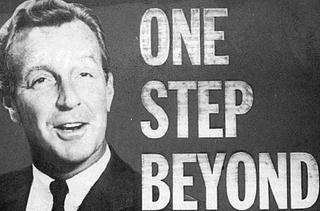
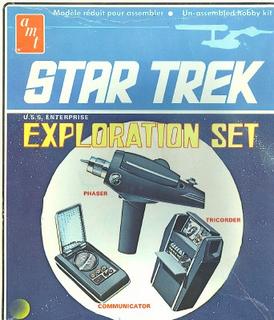 produced some amazing kits, including my all-time favorite, the Star Trek Exploration Set (which is pictured to the right, and as you can see, featured a phaser, a tricorder and a communicator). In particular, I remember being perhaps five or so years old (in 1976) and staying up late as my father applied the finishing touches on this model. After I went to bed, he would lay the models out on the staircase next to my room for the next morning - inevitably a Saturday. I would wake up, see the completed model, and begin my adventure as Captain of the Enterprise, all tricked up with the right gear.
produced some amazing kits, including my all-time favorite, the Star Trek Exploration Set (which is pictured to the right, and as you can see, featured a phaser, a tricorder and a communicator). In particular, I remember being perhaps five or so years old (in 1976) and staying up late as my father applied the finishing touches on this model. After I went to bed, he would lay the models out on the staircase next to my room for the next morning - inevitably a Saturday. I would wake up, see the completed model, and begin my adventure as Captain of the Enterprise, all tricked up with the right gear.










